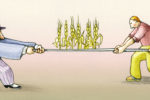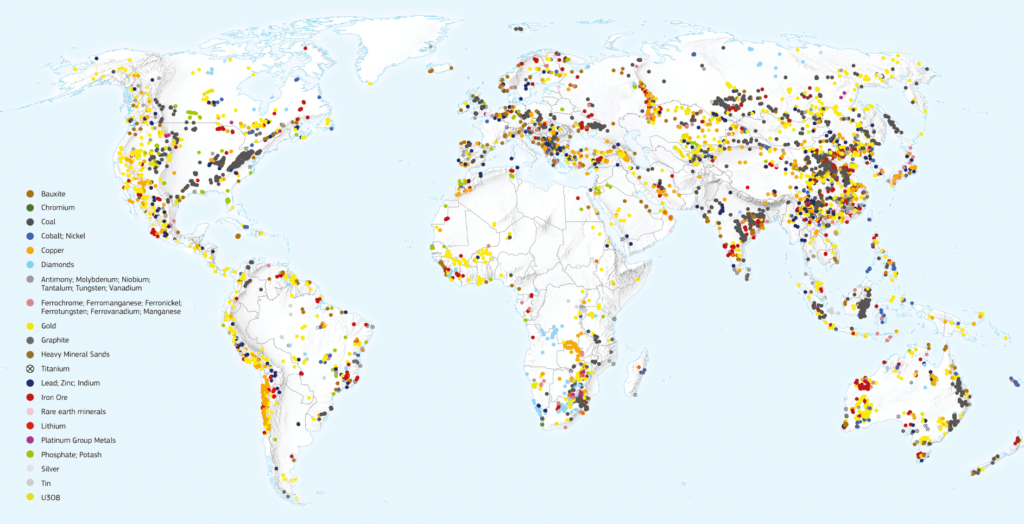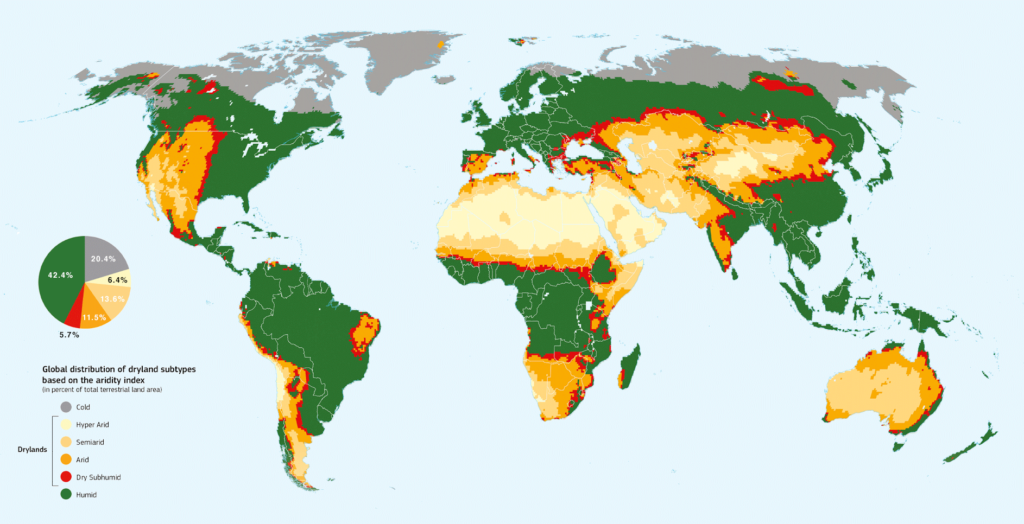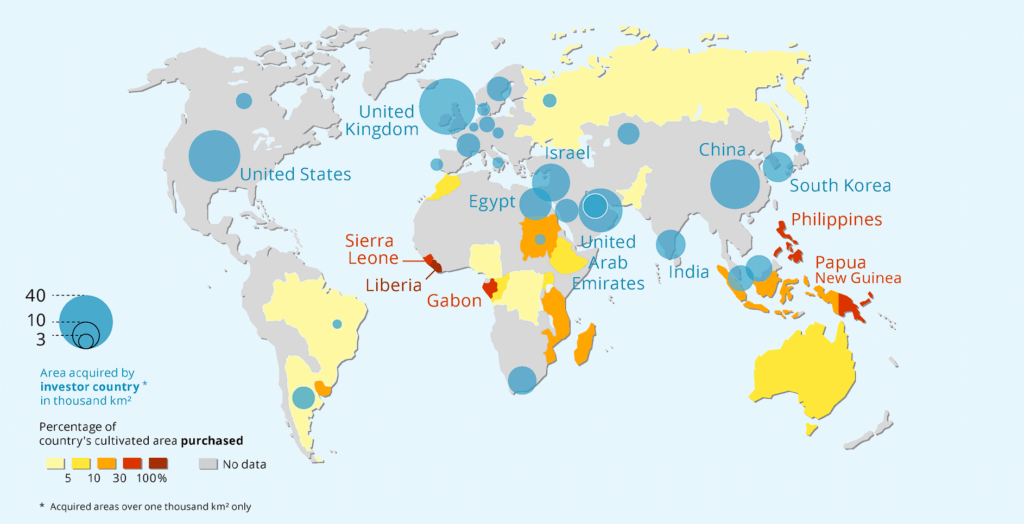Soil Degradation: At the Core of the Anthropocene’s Intricate Fragility
Land degradation is reaching alarming levels worldwide. Yet despite its direct impact on food sovereignty, climate change and biodiversity, it has long remained in the shadows of these more mediated issues. Crucial for the survival of our planet, the mitigation of land degradation is finally receiving the attention it deserves from the international community.
As terrestrial beings we are tied to the ground below our feet. Soil is our steady companion as we are riveted to earth by the force of gravity. From times ancient, human beings have recognised the paramountcy of soil for life on earth. In Latin, homo means “human” and humus “soil”, both deriving from the same semantic root. In the Bible, we are reminded in verse 3:19 of the Genesis that soil constitutes our point of origin and final destination: “for dust you are and to dust you will return”. A variety of cultures across space and time have considered earth as the ancestral mother of all life (Gaia in Ancient Greece or Pachamama for the Incas) or as a goddess of harvest serving as nourishing matrix (Demeter, Ceres). Eventually, we came to call the whole planet “Earth” even though most of its surface is water and its core, incandescent magma.
In fact, soil constitutes only a thin layer of the earthly crust – a fine membrane composed of clay particles, humus and sand – hosting billions of microorganisms, animals, plants and fungi that sustain food production and the existence of most species. Somewhat counterintuitively, however, land is a scarce and finite resource. Even though we can simply buy a bag of humus in the garden store, it takes centuries, if not millenniums, for the combined action of sun, rain, frost and soil organisms to decompose rocks into smaller particles, eventually forming successive layers of loose soil.
Soils as a vital component of the Anthropocene
Since the Neolithic humans have exerted an ever growing and lasting impact on their environment through sedentary agriculture and the domestication of livestock. For more than 8,000 years, human beings have been clearing forests, tilling, watering and fertilising cropland, giving rise to a new geological era, the Anthropocene.Soil degradation, biodiversity, food security and climate change are closely interdependent.
The Enlightenment definitely placed mankind at the centre stage of the planet’s destiny, adopting a radically instrumental and utilitarian approach to the environment based on a teleological reading of historical progress. With the Industrial Revolution, the impact of mankind on the biosphere massively intensified, as the combustion of carbon fossil and the discovery of electricity led to large-scale deforestation and the uprooting of soils through the mechanisation of agriculture and mining.
However, it is only in the twentieth century that the “great leap forward” paved the way for the massive aggravation of land degradation through unprecedented levels of population growth, large-scale industrialisation, high-yield agriculture, urban sprawl and the spread of human infrastructure. The conversion of native vegetation into crop and grazing lands to satisfy a growing global demand for food generated overcutting of vegetation and overgrazing. The generalised use of chemicals, pesticides and fertilisers led to overexposure to pollutants, heavy metals, and nitrates in soils. The use of heavy machinery in agriculture contributed to soil compaction and erosion while mining activities aggravated global soil and water contamination through the dissemination of highly toxic substances such as cyanide, chrome and mercury.
Endangered Earth
Today, the Earth is in serious danger. Soil degradation – including erosion, nutrient depletion, acidification, salinisation, compaction and chemical pollution – entails devastating consequences such as loss of biodiversity, floods, climate change, famines, forced migration and conflict. Current rates of soil degradation are alarming. According to the United Nations Environment Programme (UNEP), 33% of soil is moderately to highly degraded and each year, 24 billion tonnes of fertile soil and 15 billion trees are lost. Topsoil is being degraded 10 to 40 times faster than it is being replenished by natural processes. Wetlands have been particularly hard hit, with 54% lost since 1900. Land degradation also is a crucial issue in drylands, which cover approximately 40% of the world’s terrestrial and are highly vulnerable to climate change, erosion and desertification.
 Shutterstock/com.
Shutterstock/com.Currently, 1.5 billion people are affected by land degradation, especially rural communities, smallholder farmers, and the very poor. The loss of species and biodiversity progresses at 100 to 1,000 times the normal background rate of extinction; risks for epidemics increase with the transformation of natural ecosystems such as the melting of permafrost; floods become more frequent as the soil is no longer able to fulfill its filtering and storing function; and, eventually, famine, migration and conflict may result from desertification and the loss of arable lands. The Intergovernmental Science-Policy Platform on Biodiversity and Ecosystem Services (IPBES) estimates that 50–700 million people may migrate by 2050 because of land degradation. History is full, indeed, of warnings about civilisations such as that of Easter Island, the Greenland Norse, the Mayans and the Mycenaean Greece that have collapsed as a result of land degradation and large-scale disruption of ecosystems.
The complex fragility of the biosphere
Issues such as large-scale exploitation of land and natural resources, soil degradation, biodiversity, food security and climate change are closely interdependent and cannot be treated in isolation as the Anthropocene is characterised by complex cybernetic loops. Food production, for instance, contributes to land degradation through intensive (mono)culture and soil pollution and it accelerates climate change through the liberation of carbon into the air (it is estimated that there is three times more carbon stored in the soil than in the atmosphere). Climate change, in turn, affects food production through the degradation of soils induced by flooding, erosion and desertification. Impoverished soils, finally, further accelerate climate change because of their reduced capacity to regulate complex ecosystems and store carbon, and, ultimately, they prove unsustainable to food production.
The link between soil degradation and climate change, in particular, has started to receive increased scrutiny. Soil carbon stocks are highly vulnerable to human activities such as deforestation, tillage and unsustainable agricultural practices. It is estimated that an increase of just 1% of carbon stocks in the top meter of soils would have a higher impact than the total amount of yearly anthropogenic CO2 emissions from fossil fuel burning. Deforestation alone contributes to about 10% of all human-induced greenhouse gas emissions. The drainage of marshland and meadows for agriculture is particularly problematic as they represent the most efficient carbon store of all terrestrial ecosystems. Put simply therefore, soil protection is also climate protection.
Overcoming the agricultural taboo
As the international community is progressively growing aware of the negative impact of agriculture on the environment, soils have recently received increased attention. Less publicised than climate change or loss of biodiversity, the issue of soil degradation has been at the core of a report by the Intergovernmental Panel on Climate Change (IPCC), stressing the urgency of sustainable soil management to curb global warming and feed humanity. Already in September 2015, the UN General Assembly had adopted land degradation neutrality objective as target 15.3 of the Sustainable Development Goals (SDGs), to be achieved collectively by 2030.For too long, indeed, agriculture has been treated as a holy cow and soils as a quasi-inexhaustible resource.
There now seems to be general agreement that halting and potentially reversing land degradation is a prerequisite for fulfilling crucial environmental objectives such as maintaining biodiversity, ensuring global food security and mitigating climate change. This has brought a readiness, it seems, to closer scrutinise the impact of agriculture, which is among the greatest contributors to global warming, responsible for 80% of land degradation and also the main driver of biodiversity loss and water stress. For too long, indeed, agriculture has been treated as a holy cow, and soils as a quasi-inexhaustible resource serving the productivist credo of the green economy.
Managing land degradation and human survival
Has Earth thus arrived at a point of rupture? The issue at stake is how to reconcile agricultural production, the imperatives of food security and the growth of high-consumption lifestyles in both developed and emerging economies with the preservation of soils and, concomitantly, the climate. It is estimated that by 2050, food production will have to increase by 40%–70% to feed the world population while today 850 million people are still facing hunger on a daily basis. Gloomy Malthusian outlooks are, however, tempered by the fact that, in the long run, population growth will inexorably slow and agricultural efficiency will continue to increase with technological innovation and transfer.
Sustainable land management is one of the key means to reverse land degradation. Undermanaged areas need to increase yields by introducing modern mechanisation, irrigation, and fertilising techniques. Overmanaged arable lands, on the contrary, need to be made less exacting on the environment through reduced tillage and fertiliser usage, crop rotations and “cover crops”, and the increase of soil organic matter content. High-tech, precision farming systems, such as sensors, GPS and subsurface drip irrigation, will allow to waste less water and better target the application of fertilisers and pesticides. Sophisticated robot farmers replacing more heavy conventional machinery will contribute to alleviate soil compactionThe agriculture of tomorrow needs to combine technological innovation with more sustainable practices rooted in traditional, organic farming.
Technology, however, will not suffice to address land degradation. It needs to be complemented by broader land restoration measures such as agroforestry, the improvement of biomass and land cover, water conservation and the reflooding wetlands, as well as the mitigation of climate change and desertification. Avoiding further deforestation must become a top priority as the simplest way to protect soils and combat global warming is to preserve forests and let them grow back. In sum – and far from being contradictory – the agriculture of tomorrow needs to combine technological innovation with more sustainable practices rooted in traditional, organic farming.
Tackling land degradation and food security will thus require a holistic approach and concerted action on a transnational level. A host of multilateral agreements already exist, including on desertification, climate change, biodiversity and wetlands, that may serve as platforms from which to address land degradation. At the national level, policies and regulations will have to be implemented such as payments for ecosystem services, measures to curb soil pollution, improved urban planning, more efficient fire management as well as flood prevention. All of these measures must be designed with caution, taking into consideration the complex nexus between local livelihoods, land degradation, and climate change.
Seeking to explore and untangle these interlinkages, this Dossier aims to address some of the broader stakes the Anthropocene is currently facing: How irreversible is the damage that has been caused to Earth’s soils? How many people is the Earth able to feed and for how long? How will climate change depend and interact with changing patterns of soil distribution and depletion?
-
1
 The Ground beneath Our Feet: Food, Agriculture and Climate Change
The Ground beneath Our Feet: Food, Agriculture and Climate ChangeThe advent of settled agriculture some 12,000 years ago set in motion changes in land use that profoundly transformed our planet. Agriculture is a cause and a casualty of climate change; it is, equally, key to finding ways to mitigate our present impact. For Shaila Seshia Galvin, agrarian relations are undoubtedly crucial to finding ways to adapt to, and allay, the significant local and planetary repercussions of climate change.
-
2
 Food Security and Land Use in the 21st Century: The Return of Malthus?
Food Security and Land Use in the 21st Century: The Return of Malthus?The global population is expected to increase to about 11 billion individuals by the year 2100. For Timothy Swanson, the solution to the problem of increasingly constrained resources in the context of increasing global populations may lie in replicating the experience of the developed world in the developing. If the developed world has been successful at substituting human capital (and resulting R&D) for natural capital in the recent past, then this is likely to be possible in the developing as well.
-
3
 Abandoned Mines: The Scars of the Past
Abandoned Mines: The Scars of the PastBecause industrial society is based on the exploitation of natural resources, mines are a key axis of the world economy. But mines are running out. Many are closing. While some are restored and transformed into tourist sites, most are abandoned and continue to pose serious problems for human and environmental security. How many and where are they? Professor Marc Hufty answers.
-
4
 Land Grabs, Big Business and Large-Scale Damages
Land Grabs, Big Business and Large-Scale DamagesThe history of the world is a story of lands conquered by violence. Today, money has replaced weapons. Lands are bought. In very large quantities. The current wave of land grabbing is a phenomenon of hard conquest with dramatic consequences for local populations and the environment, which the international community has so far not really addressed, claims Christophe Gironde.
-
5
 The desertification myth?
The desertification myth?Pressures on the land have never been as great as they are at the beginning of the 21st century. Among them is desertification, turning land into arid, unproductive zones. In their reappraisal of the concept, Marc Galvin and Ronald Jaubert show that if the term is both misappropriated and hard to pin down, it nonetheless remains key for structuring aid from the international community.
-
6
 Darkness at Noon: Deforestation in the new Authoritarian Era
Darkness at Noon: Deforestation in the new Authoritarian EraThe dramatic Amazon fires images of August 2019 triggered a geopolitical outcry. Brazilian President Bolsonaro, however, unflinchingly continues to support his destructive model of Amazonian development. Susanna Hecht recalls the extent of the disaster and delves into the reasons behind such disdain for environmental concerns.
Box | Breakdown of the Global, Ice-Free Land Surface (130 million km2)
72% of land directly affected by human use:
- 37% of pastures, of which 16% are used savannahs and shrublands, 19% extensive pastures and 2% intensive pastures (since 1961, the number of people living in areas affected by desertification almost tripled).
- 22% of forests, of which 20% are managed for timber and other uses and 2% are planted
- 12% of cropland, of which 10% are non-irrigated and 2% irrigated (since 1961, the use of fertilisers increased by nearly ninefold and the use of irrigation water doubled.
- 1% of settlements and infrastructure
28% of unused land:
- 9% of intact or primary forests
- 7% of unforested ecosystems, including grasslands and wetlands (since 1970, wetland areas have declined by 30%).
- 12% of barren wilderness, rocks, etc.
Source: IPCC, Climate Change and Land, August 2019.
Land degradation | Key terms
Like many common words, the word soil has several meanings. In its traditional meaning, soil is the natural medium for the growth of plants. Soil has also been defined as a natural body consisting of layers (soil horizons) that are composed of weathered mineral materials, organic material, air and water. Soil is the end product of the combined influence of climate, topography and organisms (flora, fauna and human) on parent materials (original rocks and minerals) over time. As a result, soil differs from its parent material in texture, structure, consistency, color, chemical, biological and physical characteristics. Soil is an essential component of land and eco-systems, which both are broader concepts encompassing vegetation, water and climate in the case of land, and in addition to those three aspects, also social and economic considerations in the case of ecosystems.
The word soil is also known as dirt, waste or earth.
Soil erosion is a common term that is often confused with soil degradation as a whole, but in fact refers only to absolute soil losses in terms of topsoil and nutrients. This is indeed the most visible effect of soil degradation, but it does not cover all of its aspects. Soil erosion is a natural process in mountainous areas, but is often made much worse by poor management practices.
Land degradation has a wider scope than both soil erosion and soil degradation in that it covers all negative changes in the capacity of the ecosystem to provide goods and services (including biological and water-related goods and services, and, in the vision of LADA – Land Degradation Assessment in Dryland – also land-related social and economic goods and services).
Desertification is another common term used for (a) land degradation in dryland areas and/or (b) the irreversible change of the land to such a state it can no longer be recovered for its original use.
Mitigation is intervention intended to reduce ongoing degradation. This comes in at a stage when degradation has already begun. The main aim is to halt further degradation and to start improving resources and their functions. Mitigation impacts tend to be noticeable in the short-to-medium term: this then provides a strong incentive for further efforts. The word mitigation is also sometimes used to describe the reductions of impacts of degradation.
Rehabilitation is required when the land is already degraded to such an extent that the original use is no longer possible and the land has become practically unproductive. Longer-term and often more costly investments are needed to show any impact.
Land degradation neutrality describes the state whereby the amount and quality of land resources, necessary to support ecosystem functions and services and enhance food security, remains stable or increases within specified temporal and spatial scales and ecosystems (source: UNCDD).
The term grabbing was adopted because of the lack of transparency in the set-up of land deals, their dubious legitimacy vis-à-vis communities who until then used these areas, and the dispossession the latter suffered once the deals were implemented. Estimates vary from 20 to 45 million hectares transacted between 2005 and 2010; the most recent estimates are around 30 million hectares in 78 countries. Actually, the calculation of grabbed areas has proven extremely challenging. Information is rarely disclosed given the controversial nature and the lack of legitimacy of those deals. Moreover, land grabs include not only transnational large-scale ones but also a broad range of national and local medium- and small-size land acquisitions that are hard to quantify.
Source (except for “land degradation neutrality” and “land grabbing”: © FAO, “FAO Soils Portal”, accessed 8 November 2019, http://www.fao.org/soils-portal/about/all-definitions/en/.
Breakdown of the Global, Ice-Free Land Surface (130 million km2)
Source: IPCC, Climate Change and Land (August 2019), 4.





